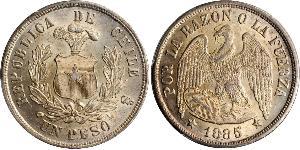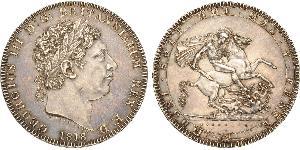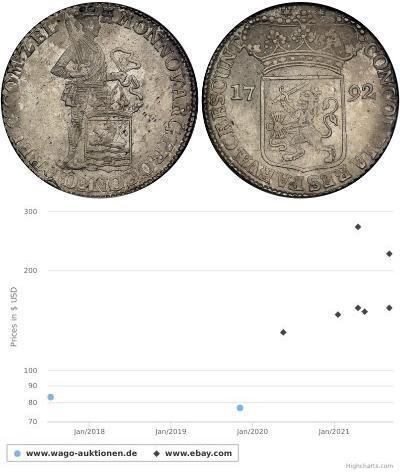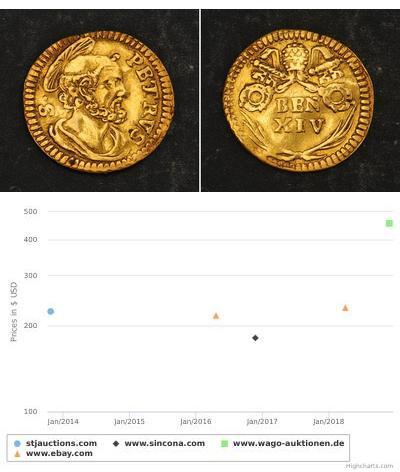1/2 Crown Kingdom of Great Britain (1707-1801) Silver George II ( ...
1746, Great Britain, George II. Silver ½ Crown Coin.
Mint Year: 1746 Reference: KM-584.3. Denomination: ½ Crown Weight: 14.87gm Diameter: 34mm Material: Silver
Obverse: Old laureate and draped bust with inscription below. Legend: GEORGIUS II DEI GRATIA Translated: "George II by the Grace of God" Reverse: Crowned cruciform shields, Order of the Garter star in center. Legend: M B F ET – H . REX . F D B – ET L D S R I – A T ET E . 17 – 46 .
For your consideration a beautiful halfcrown coin and a reminder of the sea battle in which Lord Anson captured tons of Spanish silver off the Philippines, heading towards Spain from the silver mines of Peru. The British, ever eager to thumb their proverbial and real noses at enemies, hallmarked the captured silver turned into coins by putting the word “LIMA” for the Peruvian mines near that city from which the Spanish had extracted the ore.
Admiral of the Fleet George Anson, 1st Baron Anson, PC, FRS (23 April 1697 – 6 June 1762) was a Royal Navy officer. Anson served as a junior officer during the War of the Spanish Succession and then saw active service against Spain at the Battle of Cape Passaro during the War of the Quadruple Alliance. He then undertook a circumnavigation of the globe during the War of Jenkins' Ear. Anson commanded the fleet that defeated the French Admiral de la Jonquière at the First Battle of Cape Finisterre during the War of the Austrian Succession.
Anson went on to be First Lord of the Admiralty during the Seven Years' War. Among his reforms were the removal of corrupt defence contractors, improved medical care, submitting a revision of the Articles of War to Parliament to tighten discipline throughout the Navy, uniforms for commissioned officers, the transfer of the Marines from Army to Navy authority, and a system for rating ships according to their number of guns.
Anson was the son of William Anson of Shugborough in Staffordshire and Isabella Carrier,whose brother-in-law was the Earl of Macclesfield and Lord Chancellor, a relationship that proved very useful to the future admiral. He was born on 23 April 1697, at Shugborough Manor. In February 1712, amid the War of the Spanish Succession, Anson entered the navy at the age of 15. He served as a volunteer aboard the fourth-rateHMS Ruby, before transferring to the third-rate HMS Monmouth.
Promoted to lieutenant on 17 March 1716, he was assigned to the fourth-rate HMS Hampshire in service as part of a Baltic Sea fleet commanded by Admiral John Norris. Anson transferred to the aging fourth-rate HMS Montagu in March 1718, and saw active service against Spain at the Battle of Cape Passaro in August 1718 during the War of the Quadruple Alliance. He then transferred to the second-rate HMS Barfleur, flagship of Admiral George Byng, in October 1719.
Anson was promoted to commander in June 1722 and given command of the small 8-gun HMS Weazel. Anson’s orders were to suppress smuggling between Britain and Holland, a task he swiftly and effectively performed. In recognition of his efforts he was promoted to the rank of post-captain in February 1723 and given command of the 32-gun sixth-rate HMS Scarborough with orders to escort British merchant convoys from the Carolinas. (The Ansonborough district of Charleston, South Carolina, still commemorates his time there.)
He transferred to the command of the sixth-rate HMS Garland, still on the Carolinas station, in July 1728, then to the command of the fifth-rate HMS Diamond in the Channel Fleet in 1730, and to the command of the sixth-rate HMS Squirrel back on the Carolinas station in 1731. He was given command of the 60-gun third-rate HMS Centurion in the West Africa Squadron in 1737 and, having been promoted to commodore with his broad pennant in HMS Centurion, he took command of a squadron sent to attack Spanish possessions in South America at the outset of the War of Jenkins' Ear.
After setting off later than planned, Anson’s squadron encountered successive disasters. Two of his vessels, the fifth-rate HMS Pearl and the fourth-rate HMS Severn, failed to round Cape Horn and returned home. Meanwhile, the sixth-rate HMS Wager was wrecked off the coast of Chile, where the crew subsequently mutinied. The lateness of the season forced him to round the Horn in very stormy weather, and the navigating instruments of the time did not allow for exact observations.
By the time Anson reached the Juan Fernández Islands in June 1741, only three of his six ships remained (HMS Centurion, the fourth-rate HMS Gloucester and the sloop HMS Tryal), while the strength of his crews had fallen from 961 to 335. In the absence of any effective Spanish force on the coast, he was able to harass the enemy and to sack the small port city of Paita in Peru in November 1741. The steady decrease of his crews by scurvy and the worn-out state of his remaining consorts compelled him to collect all the remaining survivors in Centurion. He rested at the island of Tinian, and then made his way to Macao in November 1742.
After considerable difficulties with the Chinese, he sailed again with his one remaining vessel to cruise in search of one of the Manila galleons that conducted the trade between Mexico and the Chinese merchants in the Philippines, where he captured the Nuestra Señora de Covadonga with 1,313,843 pieces of eight on board, which he had encountered off Cape Espiritu Santo on 20 June 1743. The charts captured with the ship added many islands (and phantom islands) to the British knowledge of the Pacific, including the Anson Archipelago.
Anson took his prize back to Macao, sold her cargo to the Chinese, kept the specie, and sailed for England. Passing a French fleet then patrolling the Channel by means of a thick fog, he reached via the Cape of Good Hope on 15 June 1744. The prize money earned from the capture of the galleon made Anson a rich man for life and bought him considerable political influence. He initially refused promotion to rear-admiral of the blue, however, out of anger that the admiralty refused to sanction a captain’s commission he had given one of his officers.
View all coins in the group
(1537 X 736 pixels, file size: ~254K)
Posted by: anonymous 2019-08-01
1746, Great Britain, George II. Silver ½ Crown Coin. Rare Historical Lima Issue! Struck from silver seized from spanish treasure fleet. Mint Year: 1746 Reference: KM-584.3. Scarce! Denomination: ½ Crown (Lima issue!) Condition: Minor scratches and moderate wear, ohterwise VF-XF! Weight: 1 ...
(2931 X 1440 pixels, file size: ~572K)
Posted by: anonymous 2023-11-19
GREAT BRITAIN 1745 1/2 CROWN LIMA KING GEORGE II SILVER WORLD COIN
(3205 X 1574 pixels, file size: ~991K)
Posted by: anonymous 2023-10-31
1745, Great Britain, George II. Beautiful Silver ½ Crown "LIMA" Coin. NGC AU-53! Mint Year: 1745 Condition: Certified and graded by NGC as AU-53! Denomination: ½ Crown - Lima issue, Struck from silver seized from spanish treasure fleet!) Reference: ESC 606, S. 3695A, KM-584.3 ($850 ...
(900 X 440 pixels, file size: ~96K)
Posted by: anonymous 2015-08-26
British Coins. British Hammered Coins. A Collection of Halfcrowns. George II , halfcrown, 1746/5, D. NONO, old laur. and dr. bust l., LIMA below, rev. crowned cruciform shields (S.3695A; ESC.607), extremely fine, scarce £400-500
(900 X 437 pixels, file size: ~99K)
Posted by: anonymous 2015-08-26
British Coins. British Hammered Coins. A Collection of Halfcrowns. George II , halfcrown, 1746, D. NONO, old laur. and dr. bust l., LIMA below, rev. crowned cruciform shields (S.3695A; ESC.606), about extremely fine £400-500
(922 X 455 pixels, file size: ~139K)
Posted by: anonymous 2015-08-25
George II, halfcrown, 1746, D. NONO, LIMA, old laur. and dr. bust l., LIMA below, rev. crowned cruciform shields (S.3695A; ESC.606), lightly toned, about extremely fine/extremely fine

-500-250-tDgKbzbiej8AAAFL0jyjltiE.jpg)
-300-150-wAXz2JOlq3QAAAFs4DJkJUvF.jpg)
-300-150-Dx_0FTEyfOQAAAGLN3_0SuUi.jpg)
-300-150-9U1nnOFsPwQAAAGLHHcX6YNc.jpg)
-300-150-CUsKbzbiYTYAAAFP5QFtcWsU.jpg)
-300-150-B0EKbzbioVAAAAFPWK5tcWsT.jpg)
-300-150-JmUKbzbisi0AAAFPSm9tcWXZ.jpg)













